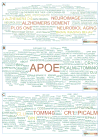Genetic studies of quantitative MCI and AD phenotypes in ADNI: Progress, opportunities, and plans
- PMID: 26194313
- PMCID: PMC4510473
- DOI: 10.1016/j.jalz.2015.05.009
Genetic studies of quantitative MCI and AD phenotypes in ADNI: Progress, opportunities, and plans
Abstract
Introduction: Genetic data from the Alzheimer's Disease Neuroimaging Initiative (ADNI) have been crucial in advancing the understanding of Alzheimer's disease (AD) pathophysiology. Here, we provide an update on sample collection, scientific progress and opportunities, conceptual issues, and future plans.
Methods: Lymphoblastoid cell lines and DNA and RNA samples from blood have been collected and banked, and data and biosamples have been widely disseminated. To date, APOE genotyping, genome-wide association study (GWAS), and whole exome and whole genome sequencing data have been obtained and disseminated.
Results: ADNI genetic data have been downloaded thousands of times, and >300 publications have resulted, including reports of large-scale GWAS by consortia to which ADNI contributed. Many of the first applications of quantitative endophenotype association studies used ADNI data, including some of the earliest GWAS and pathway-based studies of biospecimen and imaging biomarkers, as well as memory and other clinical/cognitive variables. Other contributions include some of the first whole exome and whole genome sequencing data sets and reports in healthy controls, mild cognitive impairment, and AD.
Discussion: Numerous genetic susceptibility and protective markers for AD and disease biomarkers have been identified and replicated using ADNI data and have heavily implicated immune, mitochondrial, cell cycle/fate, and other biological processes. Early sequencing studies suggest that rare and structural variants are likely to account for significant additional phenotypic variation. Longitudinal analyses of transcriptomic, proteomic, metabolomic, and epigenomic changes will also further elucidate dynamic processes underlying preclinical and prodromal stages of disease. Integration of this unique collection of multiomics data within a systems biology framework will help to separate truly informative markers of early disease mechanisms and potential novel therapeutic targets from the vast background of less relevant biological processes. Fortunately, a broad swath of the scientific community has accepted this grand challenge.
Keywords: Alzheimer's disease (AD); Bioethical issues; Biomarkers; Cerebrospinal fluid (CSF); Cognition; Copy number variation (CNV); DNA; Genome-wide association studies (GWAS); Magnetic resonance imaging (MRI); Memory; Mild cognitive impairment (MCI); Next generation sequencing (NGS); Positron emission tomography (PET); Precision medicine; RNA.
Copyright © 2015 The Authors. Published by Elsevier Inc. All rights reserved.
Figures




Similar articles
-
2014 Update of the Alzheimer's Disease Neuroimaging Initiative: A review of papers published since its inception.Alzheimers Dement. 2015 Jun;11(6):e1-120. doi: 10.1016/j.jalz.2014.11.001. Alzheimers Dement. 2015. PMID: 26073027 Free PMC article. Review.
-
The Alzheimer's Disease Neuroimaging Initiative: a review of papers published since its inception.Alzheimers Dement. 2013 Sep;9(5):e111-94. doi: 10.1016/j.jalz.2013.05.1769. Epub 2013 Aug 7. Alzheimers Dement. 2013. PMID: 23932184 Free PMC article. Review.
-
Genetic analysis of quantitative phenotypes in AD and MCI: imaging, cognition and biomarkers.Brain Imaging Behav. 2014 Jun;8(2):183-207. doi: 10.1007/s11682-013-9262-z. Brain Imaging Behav. 2014. PMID: 24092460 Free PMC article.
-
The Alzheimer's Disease Neuroimaging Initiative: a review of papers published since its inception.Alzheimers Dement. 2012 Feb;8(1 Suppl):S1-68. doi: 10.1016/j.jalz.2011.09.172. Epub 2011 Nov 2. Alzheimers Dement. 2012. PMID: 22047634 Free PMC article. Review.
-
Polygenic effects on the risk of Alzheimer's disease in the Japanese population.Alzheimers Res Ther. 2024 Feb 27;16(1):45. doi: 10.1186/s13195-024-01414-x. Alzheimers Res Ther. 2024. PMID: 38414085 Free PMC article.
Cited by
-
TNFRSF1B Gene Variants and Related Soluble TNFR2 Levels Impact Resilience in Alzheimer's Disease.Front Aging Neurosci. 2021 Feb 25;13:638922. doi: 10.3389/fnagi.2021.638922. eCollection 2021. Front Aging Neurosci. 2021. PMID: 33716716 Free PMC article.
-
Quantitative multimodal multiparametric imaging in Alzheimer's disease.Brain Inform. 2016 Mar;3(1):29-37. doi: 10.1007/s40708-015-0028-9. Epub 2016 Jan 8. Brain Inform. 2016. PMID: 27747597 Free PMC article.
-
Association of Apolipoprotein E ε4 With Medial Temporal Tau Independent of Amyloid-β.JAMA Neurol. 2020 Apr 1;77(4):470-479. doi: 10.1001/jamaneurol.2019.4421. JAMA Neurol. 2020. PMID: 31860000 Free PMC article.
-
Integrative analysis of multi-omics and imaging data with incorporation of biological information via structural Bayesian factor analysis.Brief Bioinform. 2023 Mar 19;24(2):bbad073. doi: 10.1093/bib/bbad073. Brief Bioinform. 2023. PMID: 36882008 Free PMC article.
-
TLR5 decoy receptor as a novel anti-amyloid therapeutic for Alzheimer's disease.J Exp Med. 2018 Sep 3;215(9):2247-2264. doi: 10.1084/jem.20180484. J Exp Med. 2018. PMID: 30158114 Free PMC article.
References
Publication types
MeSH terms
Substances
Grants and funding
LinkOut - more resources
Full Text Sources
Other Literature Sources
Medical
Miscellaneous

